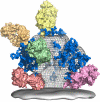Broadly neutralizing antibodies present new prospects to counter highly antigenically diverse viruses
- PMID: 22798606
- PMCID: PMC3600854
- DOI: 10.1126/science.1225416
Broadly neutralizing antibodies present new prospects to counter highly antigenically diverse viruses
Abstract
Certain human pathogens avoid elimination by our immune system by rapidly mutating the surface protein sites targeted by antibody responses, and consequently they tend to be problematic for vaccine development. The behavior described is prominent for a subset of viruses--the highly antigenically diverse viruses--which include HIV, influenza, and hepatitis C viruses. However, these viruses do harbor highly conserved exposed sites, usually associated with function, which can be targeted by broadly neutralizing antibodies. Until recently, not many such antibodies were known, but advances in the field have enabled increasing numbers to be identified. Molecular characterizations of the antibodies and, most importantly, of the sites of vulnerability that they recognize give hope for the discovery of new vaccines and drugs.
Figures


References
-
- Duffy S, Shackelton LA, Holmes EC. Rates of evolutionary change in viruses: patterns and determinants. Nat. Rev. Genet. 2008;9:267. - PubMed
-
- UNAIDS World Aids Day Report. UNAIDS; Geneva: 2011. How to get to zero: Faster. Smarter. Better.
-
- Graham-Rowe D. Epidemiology: Racing against the flu. Nature. 2011;480:S2. - PubMed
-
- Shepard CW, Finelli L, Alter MJ. Global epidemiology of hepatitis C virus infection. Lancet Infect. Dis. 2005;5:558. - PubMed
Publication types
MeSH terms
Substances
Grants and funding
LinkOut - more resources
Full Text Sources
Other Literature Sources

